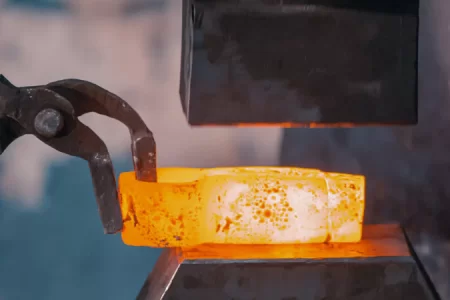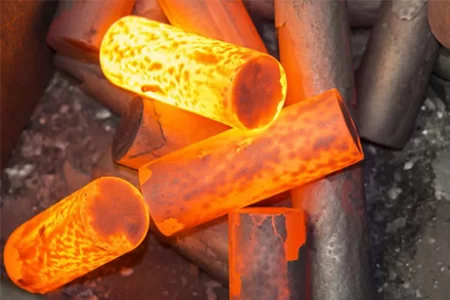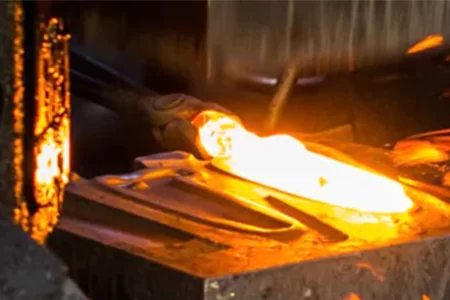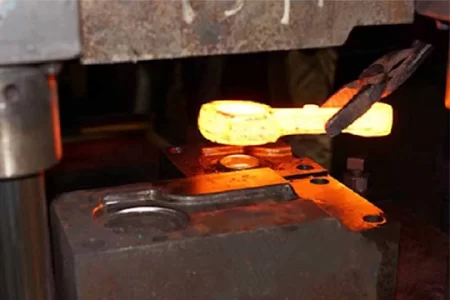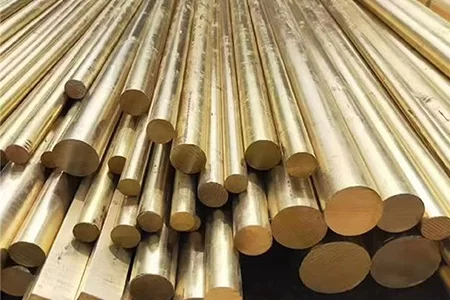By sharing knowledge, experience and views in the field of forging technology, we help you understand, learn and apply relevant technologies.

Hulk Metal Forging Technology
Share technical experience
-
Home>
-
Blog>
-
Technology>
Factors to Consider During Hot Forging Process

Hot forging is a metal processing process that heats metal to a certain temperature and uses mechanical force to deform it into the desired shape. Compared with cold forging, hot forging has significant advantages in material plasticity, forming accuracy, and application range. Hot forging technology is widely used in various mechanical parts, mining equipment, aerospace devices, and other fields. It plays an irreplaceable role, especially in the manufacture of parts with high strength and complex shapes.
This article will deeply explore the basic principles of hot forging and its key technologies in practical applications, analyze the main factors affecting the quality and efficiency of hot forging, and propose best practices and technological innovations, striving to provide practitioners in the hot forging industry with Comprehensive theoretical guidance and practical experience.
Basic principles of hot forging
Hot working properties of metals
The basic principle of hot forging is to heat the metal to a sufficient temperature to increase plasticity and reduce the yield strength of the metal. Different metal materials have different heating temperature ranges. Under high temperatures, the lattice structure of the metal will change, showing higher fluidity and facilitating forging. The heating temperature not only affects the plasticity of the material but also determines its internal structure and ultimate mechanical properties.
Differences between hot forging and cold forging
Hot forging and cold forging are the two main methods in metalworking. Hot forging heats the metal to a temperature above its recrystallization temperature, which usually requires higher equipment energy and temperature control accuracy, but it can effectively prevent cracking or other deformation problems of the metal during plastic deformation. Cold forging is carried out at room temperature or low temperature and is suitable for metal materials with good plasticity, especially when high-precision forming is required. The advantage of hot forging is that it is suitable for parts with complex shapes and large sizes, and can reduce processing stress while improving the mechanical properties of the material.
The main factors affecting the hot forging process
Effect of heating temperature on forging results
In the hot forging process, the heating temperature of the metal directly affects its fluidity, plasticity and final organizational properties. Too low a heating temperature may cause cold cracking on the metal surface, while too high a temperature may cause overburning, oxidation of the metal surface, and even the formation of excessive pores. The appropriate heating temperature is not only conducive to the smooth forming of the metal but also maintains its good mechanical properties. Therefore, temperature control is a crucial part of hot forging.
Control of heating before forging
Heating before forging is a key step to ensure the smooth progress of the hot forging process. The metal blank must be heated to a certain temperature, which is usually controlled by furnace temperature, induction heating temperature, etc. The heating temperature range of different materials (such as aluminum, copper, stainless steel, etc.) is different and needs to be precisely controlled according to the characteristics of the material. Especially for high-performance materials such as aluminum alloys, heating temperature control is more stringent to avoid excessively high temperatures that may cause volatilization of alloy elements or excessive grain size, affecting the quality of the final product.
During the forging process, uniform heating and a reasonable heating rate are necessary conditions to ensure the quality of the metal blank. Uniform heating can avoid local overheating or overcooling and ensure that the material has consistent mechanical properties throughout the forging process.
Temperature control management during the deformation process
During the deformation process, the management of forging temperature is particularly important. Forging equipment is usually equipped with a temperature control system to monitor and adjust the temperature of the blank in real-time. The precise temperature control system helps to improve metal fluidity, reduce metal resistance in the mold, and improve forming accuracy. In addition, the application of temperature control technology can also optimize the internal structure of the metal, reduce the stress caused by uneven temperature, and further improve the mechanical properties of forgings.
Lubrication technology during hot forging
The role and importance of lubrication
During hot forging, the use of lubricants plays a vital role in forging quality, forming load, and die life. Lubricants can effectively reduce the friction coefficient between the mold and the blank, improve the fluidity of the metal, and improve the filling performance of the mold, thereby reducing the torque required during the forming process. Proper lubrication not only helps the forgings to be de-molded smoothly but also avoids surface defects on the forgings caused by excessive friction.
At the same time, lubrication technology helps to reduce mold wear, improve mold durability,y and reduce production costs. Good lubrication conditions can form a protective film between the mold and the blank, preventing heat from being quickly transferred to the mold, thereby slowing down the change in mold temperature and extending the service life of the mold.
Selection and application of lubricants
The selection of lubricant should be comprehensively evaluated based on forging materials, process requirements, and die type. Common types of lubricants include oil-based lubricants, solid lubricants, and gas lubricants. Oil-based lubricants can provide good anti-friction effects but may produce smoke or pollution at high temperatures, so their use conditions need to be strictly controlled. Solid lubricants are suitable for high-temperature environments, have strong heat resistance, and can effectively reduce the friction coefficient.
Suitable lubricants can not only improve forming efficiency but also ensure the surface finish of forgings and reduce scratches and other defects on the forging surface. With the development of technology, more and more environmentally friendly lubricants are put on the market, which can not only achieve lubrication effects but also reduce pollution to the environment.
Lubrication failure and its consequences
Poor lubrication or improper lubricant selection will increase friction, resulting in poor metal fluidity and prone to defects during forging. Lubricant failure may also cause surface defects on forgings such as burns, die sticking, scratches, etc. In order to avoid lubrication failure, the quality of the lubricant should be checked regularly during the production process and adjusted according to actual production needs.
Selection and design of mold materials
Basic requirements for forging dies
During the hot forging process, the mold is subjected to extreme conditions such as high temperature and high pressure, so the material selection of the mold is crucial. The mold must have high strength, hardness, wear resistance and good thermal fatigue performance, and be able to withstand continuous deformation and temperature cycles. The design of the mold must not only meet the process requirements but also ensure that it can operate stably for a long time in a high-temperature environment.
Selection of mold materials
Common mold materials include high alloy tool steel, high-temperature resistant alloy steel, wear-resistant alloy materials, etc. Different mold materials have different mechanical properties. Choosing the right mold material can not only ensure the quality of the forgings but also effectively extend the service life of the mold. For example, tool steel has good cutting performance and wear resistance, but its high-temperature resistance is relatively poor and is suitable for forging processes with lower temperatures. High-temperature resistant alloy steel has excellent high-temperature resistance and is suitable for high-temperature forging scenarios.
Key Considerations in Mold Design
The design of the mold requires consideration of many factors, including the mold structure, cooling system, surface treatment, etc. A reasonable cooling system design is crucial to the temperature control of the die, which can effectively extend the die's life and maintain the quality of forgings. In addition, the design of the mold shape should be optimized based on factors such as the fluidity of the material and the strength of the mold to ensure that the mold can withstand deformation force and maintain stability under high temperature and high pressure.
Hot forging equipment and technology
Types and applications of hot forging equipment
Hot forging equipment includes forging presses, hydraulic presses, hammer forging machines, etc., which play different roles in the forging process. Forging presses are usually used for mass production and are suitable for forging parts with high precision requirements; hydraulic presses are suitable for forgings with complex shapes and large sizes; hammer forging machines are suitable for rough processing of large-shaped and large-sized metals. According to different production requirements, it is very important to choose the right forging equipment.
Thermal load and durability of equipment
Hot forging equipment needs to withstand a large amount of thermal load and mechanical pressure during long-term operation. The durability of the equipment is the basis for ensuring production efficiency and product quality.
The durability of hot forging equipment not only depends on the material and structure of the equipment itself but is also closely related to the equipment's thermal management system, lubrication system, and working environment. During the equipment design process, special consideration needs to be given to the impact of high-temperature environments on materials to ensure that the equipment can operate stably under high heat loads.
For example, when forging machines and hydraulic presses work at high temperatures for a long time, some parts of the machine body (such as the hydraulic system, power system, etc.) may be damaged by heat. Therefore, when designing equipment, effective thermal isolation and heat dissipation measures need to be taken to prevent excessive temperatures from causing premature failure of the equipment. In addition, regular inspection and maintenance of equipment during the forging process is also an important measure to extend the life of the equipment and ensure that the equipment is always in the best working condition.
Technological Innovation of Hot Forging Equipment
With the development of technology, the intelligence and automation level of hot forging equipment is constantly improving. Modern hot forging equipment is not only equipped with advanced temperature and force control systems, but also incorporates real-time monitoring and data acquisition technologies. These technologies can accurately control various parameters in the forging process (such as temperature, pressure, forming speed, etc.) and provide real-time feedback to the operator to ensure process stability and consistency.
In addition, many new hot forging equipment adopt advanced energy-saving technologies to reduce energy consumption and improve production efficiency. For example, adopting efficient heating furnaces, optimizing power systems and using environmentally friendly gas heating can not only reduce production costs but also reduce the impact on the environment. The intelligent production management system can also optimize the production process through big data analysis, further improving forging accuracy and production efficiency.
Quality control of the hot forging process
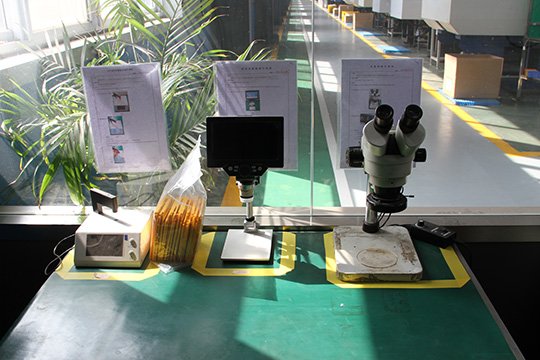
Importance of Quality Control
Quality controll during the hot forging process is a critical step in ensuring that the final forgings meet design requirements and satisfy performance standards. Since forgings undergo multiple processes such as heating, deformation, and cooling during the production process, each link may affect the quality of the forgings. Especially in high-temperature environments, the internal structure and surface quality of metals are more susceptible to changes in temperature, pressure, and stress, so each process link must be strictly controlled.
Core Elements of Quality Control
Quality control involves many aspects, the most critical factors include the following:
Dimensional control: Ensure that the size and shape of the forgings meet the design requirements. Since the metal has strong fluidity during hot forging, if the temperature and pressure are not properly controlled, the forgings may have dimensional deviations or shape defects. Therefore, the die size, deformation force, and other parameters of the forging process need to be precisely controlled during the forming process.
Surface quality control: The quality of the forging surface directly affects its appearance and subsequent processing performance. Surface defects such as oxidation, cracks, scratches, etc. will affect the performance of forgings. Therefore, effective lubrication, temperature control, and other measures are needed to ensure the smoothness of the forging surface.
Internal quality control: The internal structure of the forging is crucial to its mechanical properties. By controlling the appropriate heating temperature and deformation process, the internal structure of the forging can be ensured to be uniform and refined, avoiding defects such as pores and inclusions. Especially for high-strength, load-bearing components, it is necessary to ensure that there are no internal defects that may affect performance.
Nondestructive testing and quality inspection
After the hot forging process is completed, the forgings usually need to undergo strict quality inspection. Common detection methods include non-destructive testing technologies such as X-ray testing, ultrasonic testing, and magnetic particle testing. These methods can detect possible defects inside forgings and ensure the safety and reliability of forgings.
In addition, metallographic analysis using instruments such as electron microscopes can further confirm the internal structure of the forgings to ensure that they meet the requirements of mechanical properties such as strength and toughness. Through strict quality inspection, we can effectively prevent unqualified products from entering the market and reduce risks in the production and use processes.
Future development trend of hot forging
Intelligence and Automation
With the acceleration of the intelligentization process of the manufacturing industry, the hot forging industry is also gradually developing towards automation and intelligence. Future hot forging production lines will pay more attention to automated operation and data management. Every link from raw material feeding, heating, and deformation to cooling, inspection, etc. will be precisely controlled and provided with real-time feedback through automated systems. The introduction of intelligent equipment can not only improve production efficiency but also reduce human operating errors and improve product consistency and quality.
Application of high-performance materials
With the continuous research and development of new materials, hot forging will play an important role in the processing of higher-performance materials. For example, the widespread application of high-performance materials such as high-temperature alloys, wear-resistant alloys, and superalloys requires further improvement of hot forging processes in terms of material forming capability, precision control, and surface quality. In order to adapt to the processing requirements of these new materials, hot forging technology will need to be continuously improved and gradually developed to a higher technical level.
Environmental protection and energy saving
With the increasing environmental awareness and the global demand for resource conservation, the hot forging industry is also committed to reducing energy consumption, lowering carbon emissions, and improving the environmental friendliness of the production process. In the future, the hot forging industry will pay more attention to the use of energy-saving equipment and environmentally friendly materials to promote the application of green manufacturing technology. For example, adopting efficient and energy-saving heating systems, heat recovery technologies, environmentally friendly lubricants, etc. can reduce resource waste and environmental pollution.
As a traditional metal processing technology, hot forging still occupies an important position in modern manufacturing. With the continuous advancement of science and technology, hot forging technology is also constantly innovating and developing. From heating control and lubrication technology to mold design and quality control, every link directly affects the quality and production efficiency of forgings. Through continuous technological innovation and scientific management, hot forging will provide solid technical support for the manufacturing of higher-performance and higher-precision parts in the future. At the same time, with the introduction of intelligent, automated, and environmentally friendly technologies, the application prospects of hot forging technology will be broader.
Article Navigation
Article Navigation
Industries
Foundries
-

July.01, 2024
Difference between hot forging and cold forging
READ MORE
-

June.27, 2024
What are the advantages and disadvantages of the hot forging process?
READ MORE
-

January.18, 2024
Forging: What Is It? What Are The Different Types of Hot Forging?
READ MORE
-

November.29, 2024
What is steel forging?
READ MORE
-

November.08, 2024
How to produce high-quality wire pulling grips?
READ MORE
-

July.30, 2024
What are the materials for hot forging?
READ MORE



